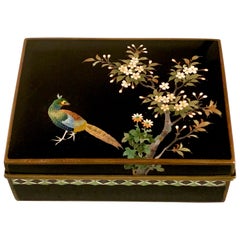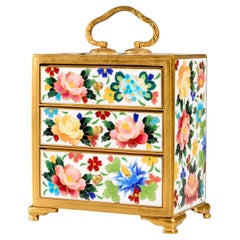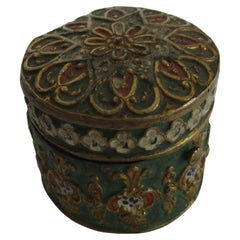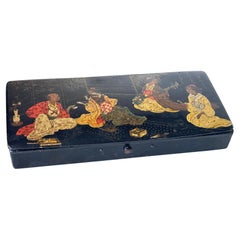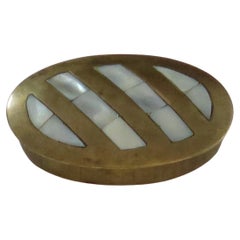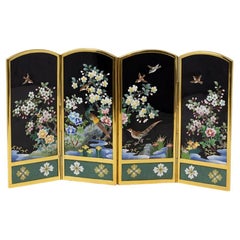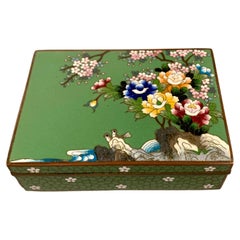Inaba Cloisonne Co. Furniture
to
2
1
3
1
3
3
1
3
2
1
1
2
2
2
1
1
3
3
3
1
12,381
3,859
2,504
2,228
Creator: Inaba Cloisonne Co.
Japanese Cloisonne Box by Inaba, Meiji Period, circa 1900, Japan
By Inaba Cloisonne Co.
Located in Austin, TX
A fine Japanese cloisonne hinged box with pheasant and autumn foliage, by Inaba Nanaho and the Inaba Cloisonne Company, Meiji period, circa 1900, ...
Category
Early 1900s Japanese Meiji Antique Inaba Cloisonne Co. Furniture
Materials
Copper, Enamel, Metal
Late Meji Period Japanese Cloisonné Miniature 3 Drawer Chest by Inaba Nanaho
By Inaba Cloisonne Co.
Located in Morristown, NJ
An exquisite Japanese miniature cloisonné chest by Inaba Nanaho of Nagoya, finely crafted in the early 20th century, bridging the Meiji and Taishō ...
Category
Early 20th Century Japanese Meiji Inaba Cloisonne Co. Furniture
Materials
Metal, Enamel
Antique Cloisonne Inkwell
By Inaba Cloisonne Co.
Located in Vienna, AT
This inkwell comprises a base and hinged cover. The base is elaborately decorated with red, gold, blue and white against a green background.
The inside of the inkwell is colored red...
Category
Early 20th Century French Art Deco Inaba Cloisonne Co. Furniture
Materials
Brass
Related Items
Japanese Lacquered Box Meiji Decorative Box and Ink box, circa 1880
Located in Auribeau sur Siagne, FR
Nice Japanese glove box in red, yellow and black lacquered wood dating from the end of the 19th century. It is decorated with delicate gold, black and red characters.
Inside you have...
Category
19th Century Japanese Meiji Antique Inaba Cloisonne Co. Furniture
Materials
Wood, Lacquer
$334 Sale Price
20% Off
H 1.19 in W 8.67 in D 3.94 in
Antique metal Pill Box inlaid to lid, English Edwardian period
Located in Lincoln, Lincolnshire
This is a small oval shaped antique metal Pill Box with Inlay to the lid and dating to the Edwardian or late Victorian period.
The box is made ...
Category
Late 19th Century English Edwardian Antique Inaba Cloisonne Co. Furniture
Materials
Stone, Brass, Bronze
Japanese Meiji Period Cloisonne Enamel Vase by Ando Jubei
By Ando Jubei
Located in Newark, England
Free international shipping
Ando Cloisonne Company Mark
From our Japanese collection, we are delighted to introduce this Japanese Cloisonne Enamel Vase by Ando Jubei. The Cloisonn...
Category
Early 1900s Japanese Meiji Antique Inaba Cloisonne Co. Furniture
Materials
Enamel, Wire
Japanese Meiji Period Cloisonne Enamel Sake Pot
Located in Newark, England
Fine Japanese Meiji period cloisonne enamel Sake pot. The Sake pot of rounded form with with clean edges profusely decorated with blossoming flowers throughout upon a black ground ba...
Category
Late 19th Century Japanese Meiji Antique Inaba Cloisonne Co. Furniture
Materials
Metal, Enamel
Japanese Meiji Period Silver and Mixed Metals Cigar Decorative Box by Hidekuni
Located in Newark, England
From our Japanese collection, we are delighted to introduce this Japanese Silver and Mixed Metals Box by Hidekuni. The Japanese Box of large rectangular form lined in a dark asian ro...
Category
Early 1900s Japanese Meiji Antique Inaba Cloisonne Co. Furniture
Materials
Gold, Silver
$6,142
H 2.56 in W 8.47 in D 5.71 in
JAPAN IMPERIAL 1900 Meiji Period Tripode Koro Censer In Cloisonné Enamel With
Located in Miami, FL
Japanese tripod Koro from the Meiji Period (1868-1912).
This is a rare and beautiful antique koro censer, created in the imperial Japan during the Meiji period (1868-1912), circa 1900. It was carefully crafted in solid bronze and copper with silver wires and embellished with applications of polychromatic Cloisonné enamels and aventurine. The designs depict organics and natural motifs such mythological animals and flowers.
The Chrysanthemum Symbol
In Imperial Japan, the chrysanthemum (Kiku) was a potent symbol of the imperial family and the emperor himself, representing longevity, royalty, and divine power. The 16-petaled chrysanthemum is the Imperial Seal and crest, found on passports, coins, and the Chrysanthemum Throne. This association dates back to the Kamakura period (1185–1333), particularly with Emperor Go-Toba's fondness for the flower, establishing its link to imperial authority and lineage. The connection between the chrysanthemum and the imperial family began when Emperor Go-Toba adopted it as a personal emblem, aligning it with the strength and refinement of the emperor's rule. During the Meiji Period, the 16-petaled chrysanthemum crest, solidifying the association with the imperial family, was established during this time.
The Meiji Imperial Period
This is an era of Japanese history that extended from October 23, 1868 to July 30, 1912.The Meiji era was the first half of the Empire of Japan, when the Japanese people moved from being an isolated feudal society at risk of colonization by Western powers to the new paradigm of a modern, industrialized nation state and emergent great power, influenced by Western scientific, technological, philosophical, political, legal, and aesthetic ideas. As a result of such wholesale adoption of radically different ideas, the changes to Japan were profound, and affected its social structure, internal politics, economy, military, and foreign relations. The period corresponded to the reign of Emperor Meiji. It was preceded by the Keiō era and was succeeded by the Taishō era, upon the accession of Emperor Taishō.
Country: Imperial Japan.
Period: Meiji, 1890-1910.
Technique: Silver Wire Cloisonné over copper and bronze.
Weight: 416.80 Grams, (0.417 Kg).
Measurements:118 mm by 115 mm (4.65 x 4.52 Inches).
Koro
This term refers to a Japanese censer, incense burner, perfume burner or pastille burner is a vessel made for burning incense or perfume in some solid form. They vary greatly in size, form, and material of construction, and have been in use since ancient times throughout the world. They may consist of simple earthenware bowls or fire pots to intricately carved silver or gold vessels, small tabletop objects a few centimeters tall to as many as several meters high. Many designs use openwork to allow a flow of air. In many cultures, burning incense has spiritual and religious connotations, and this influences the design and decoration of the censer.
Cloisonné
This is an enameling technique in which the pattern is formed by wires soldered to the surface of the object to be decorated, which is usually made from copper, forming cells or cloisons, each of which holds a single colour of enamel paste which is then fired, and ground and polished. The champleve technique also uses an enameling technique, but the cells are formed by carving into the surface of the object, or in the casting. The cloisonne technique has been in use since the 12th century BC in the west, but the technique did not reach China until the 13th or 14th century. It became popular in China in the 18th century. Initially bronze or brass bodies were used, and in the 19th century copper, at which time the quality of the items produced began to decline. Chinese cloisonné is the best-known enamel cloisonné, though the Japanese produced large quantities from the mid-19th century, of very high technical quality. In the west the cloisonne technique was revived in the mid-19th century following imports from China, and its use continued in the Art Nouveau and Art Deco periods.
Condition: Basically, is in great antique condition, near mint, with insignificant and minimal usage, in great condition. All parts are secured in the settings. This Japanese Meiji Koro...
Category
Early 1900s Japanese Meiji Antique Inaba Cloisonne Co. Furniture
Materials
Silver, Bronze, Copper, Enamel
$1,398 Sale Price
30% Off
H 4.65 in Dm 4.52 in
Japanese Meiji Period Antique Lacquer Box with Gold Maki-e Decoration
Located in New York, NY
A fine antique Japanese Meji Period lacquer box decorated with a fan and a stylized star shaped window in the maki-e technique. The fan at the top right corner, fully opened depictin...
Category
19th Century Japanese Meiji Antique Inaba Cloisonne Co. Furniture
Materials
Lacquer
$1,700
H 4.5 in W 3.25 in D 1.88 in
Japanese Three Drawer Copper Lined Hibachi. Circa 1870
Located in Charleston, SC
KYOTO STYLE NAGA HIBACHI (FIREBOX BRAZIER GRILL), Japanese, Meiji Period, The rectangular hibachi is of Keyaki (Zelkova) wood construction with the original copper liner, and a colum...
Category
1870s Japanese Antique Inaba Cloisonne Co. Furniture
Meiji Japanese Totai Cloisonne Enamel Porcelain Box
Located in Long Island City, NY
An antique Japanese late Meiji era covered Totai enamel on porcelain trinket or jewelry box. Circa: late 19th century to early 20th century. The ware is enameled with a polychrome floral medallion with butterflies and berries, on the top of the cover, surrounded by floral, and foliage patterns made in the Cloisonne technique. A hand painted image of a flower, under the cover. Dated, 01.12.08, and probably numbered, 6, on the bottom. Totai Shippo...
Category
Early 20th Century Japanese Meiji Inaba Cloisonne Co. Furniture
Materials
Enamel
Antique Japanese Cloisonné Meiji Enamel Box with Roosters
Located in Long Island City, NY
An antique Japanese Meiji era covered enamel over brass trinket or jewelry box. Circa: late 19th century to early 20th century. The ware is enameled with a polychrome image of a roos...
Category
Early 20th Century Japanese Meiji Inaba Cloisonne Co. Furniture
Materials
Brass, Enamel
Exquisite Japanese Wireless Cloisonné Dragon Motif Vase, Meiji / Taisho Period
Located in West Palm Beach, FL
Japanese Wireless Cloisonné Enamel Vase, likely from the Meiji period (1868–1912) or possibly the early Taisho period (1912–1926). The vase features a dynamic depiction of a Japanese...
Category
Early 20th Century Japanese Meiji Inaba Cloisonne Co. Furniture
Materials
Copper
Japan 1890 Meiji Period Decorative Vase In Cloisonné Enamel With Wood Base
Located in Miami, FL
Japanese vase from the Meiji Period (1868-1912).
Beautiful antique decorative vase, created in Japan during the Meiji period (1868-1912), circa 1890s. It was carefully crafted in so...
Category
1890s Japanese Meiji Antique Inaba Cloisonne Co. Furniture
Materials
Bronze, Enamel
$488 Sale Price / set
30% Off
H 4.5 in Dm 3.5 in
Previously Available Items
Japanese Mid-Century Cloisonne Enamel Table Screen by Inaba
By Inaba Cloisonne Co.
Located in Newark, England
SIGNED WITH THE INABA MARK
From our Japanese collection, we are pleased to offer this Japanese Cloisonne Enamel Table Screen by Inaba. The Cloisonne Enamel Table screen with four in...
Category
Mid-20th Century Japanese Mid-Century Modern Inaba Cloisonne Co. Furniture
Materials
Brass, Enamel
Japanese Inaba Cloisonne Trinket Box, Meiji Period, Japan
By Inaba Cloisonne Co.
Located in Austin, TX
A charming Japanese avocado green cloisonne box by the Inaba Cloisonne Company, late Meiji Period, Japan.
The rectangular box features a hinged top decorated with a birds and flow...
Category
1910s Meiji Vintage Inaba Cloisonne Co. Furniture
Materials
Brass, Copper, Enamel
Japanese Inaba Black Ground Cloisonne Enamel Square Dish, Meiji Period, Japan
By Inaba Cloisonne Co.
Located in Austin, TX
A lovely Japanese black ground cloisonne enamel square dish by the Inaba Cloisonne company, Meiji Period, circa 1900, Japan.
The square dish features rounded corners and a gently ...
Category
Early 1900s Japanese Meiji Antique Inaba Cloisonne Co. Furniture
Materials
Copper, Enamel
H 1 in W 6.88 in D 6.88 in
Japanese Cloisonne Millefleur Box by Inaba, Taisho Period, Japan
By Inaba Cloisonne Co.
Located in Austin, TX
A fantastic small Japanese cloisonne trinket or jewelry box by Inaba, Taisho Period, circa 1920, Japan.
The cloisonne box with a slightly domed and hinged lid, set on raised feet. The box decorated all over in a dense millefleurs (thousand flowers) pattern in an unusually bright rainbow of colored enamels, all against a navy blue enamel ground. The dense pattern of colorful flowers highly reminiscent of Takashi Murakami's flower fields paintings...
Category
1920s Japanese Taisho Vintage Inaba Cloisonne Co. Furniture
Materials
Brass, Copper, Enamel
Old or Antique Japanese Inaba Cloisonne Table Screen with Birds & Flowers
By Inaba Cloisonne Co.
Located in Philadelphia, PA
A fine Japanese table screen.
By the Inaba Cloisonne Company.
One side has polychrome cloisonné enamel depictions of peacocks & other birds gathering among flowers & a stream....
Category
20th Century Japanese Meiji Inaba Cloisonne Co. Furniture
Materials
Silver Plate, Enamel
H 7.13 in W 12.75 in D 0.25 in
Antique Japanese Enameled Vase with Bird & Bee, Signed Cloissone, Circa 1920
By Inaba Cloisonne Co.
Located in Big Flats, NY
An antique Japanese Cloisonne vase offers metal construction with hand enameled design to include reserves with rooster, bee and styli...
Category
Early 20th Century Japanese Inaba Cloisonne Co. Furniture
Materials
Metal, Enamel
H 8.5 in W 4.5 in D 4.5 in
Inaba Cloisonne Co. furniture for sale on 1stDibs.
Inaba Cloisonne Co. furniture are available for sale on 1stDibs. These distinctive items are frequently made of metal and are designed with extraordinary care. There are many options to choose from in our collection of Inaba Cloisonne Co. furniture, although black editions of this piece are particularly popular. Many of the original furniture by Inaba Cloisonne Co. were created in the Art Deco style in japan during the early 20th century. If you’re looking for additional options, many customers also consider furniture by Yabu Meizan, Eisuke Miyao, and Makuzu Kozan. Prices for Inaba Cloisonne Co. furniture can differ depending upon size, time period and other attributes — on 1stDibs, these items begin at $449 and can go as high as $2,200, while a piece like these, on average, fetch $1,050.
